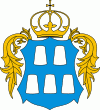Dolyna
 |
 |
The city's history reaches the 10th century, making it one of oldest in the region. By the 14th century Dolyna became renowned for its salt mine. In 1349 the city came under the rule of the Kingdom of Poland, where it remained until 1772 (see Partitions of Poland). In 1525 Dolyna, or Dolina, as it is called in Polish, was granted city rights under the Magdeburg law and the right to trade salt similar to that of Kolomyia. In 1740 in the city there was a riot of opryshky (Ukrainian rebels).
In 1772 the city fell to Austrians and in 1791 it lost its status. During the second half of the 19th century a railroad line linking Stryi with Stanislaviv was led through the city. By the end of the 19th century big fires destroyed the town completely. The first decade of the new century was dedicated to the revival of the town. After the collapse of Austria-Hungary, reborn Polish and Ukrainian states struggled for control over Dolyna in a fratricidal war won by Poles (see Polish-Ukrainian War). In the Second Polish Republic, the town, with population of almost 10 000, belonged to the Stanisławów Voivodeship and was the capital of the Dolina County. Neighboring villages were inhabited by German settlers, who came there in the times of Joseph II.
During World War II the city was occupied by the USSR (September 1939 - June 1941), Hungary (July 1941), and Germany (August 1941-1944). During the German occupation, the Jewish population of Dolyna was murdered with only a few survivors. Most were murdered in Dolyna itself, including on August 3, 1942 when German police and their Ukrainian police auxiliaries drove 3500 Jews into the market square. They shot numerous children, sent some of the able bodied to labor camps, and took the remaining 2500 to the Jewish cemetery where they were shot. After the Germans removed valuables from the bodies, they ordered locals to bury the bodies in a mass grave. Some Jews had hidden and fled to the forests to join Jewish partisan groups. However, Ukrainian policeman and the Germans hunted down those in hiding and murdered them too.
After the war, Dolyna became part of the Ukrainian SSR. In the 1950s, oil deposits were discovered in the region which by 1958 produced 65% of oil extracted in the Ukrainian SSR. In the 1960s, the Dolynske oil field was the oil field that produced the largest amount of oil of the whole USSR.
Since 1991, Dolyna has been in independent Ukraine. Its oil field is one of the most powerful of Ivano-Frankivsk Oblast (region).
Until 18 July 2020, Dolyna was the administrative center of Dolyna Raion. The raion was abolished in July 2020 as part of the administrative reform of Ukraine, which reduced the number of raions of Ivano-Frankivsk Oblast to six. The area of Dolyna Raion was merged into Kalush Raion.
Map - Dolyna
Map
Country - Ukraine
 |
 |
| Flag of Ukraine | |
During the Middle Ages, Ukraine was the site of early Slavic expansion and the area later became a key centre of East Slavic culture under the state of Kievan Rus', which emerged in the 9th century. The state eventually disintegrated into rival regional powers and was ultimately destroyed by the Mongol invasions of the 13th century. The area was then contested, divided, and ruled by a variety of external powers for the next 600 years, including the Polish–Lithuanian Commonwealth, the Austrian Empire, the Ottoman Empire, and the Tsardom of Russia. The Cossack Hetmanate emerged in central Ukraine in the 17th century, but was partitioned between Russia and Poland, and ultimately absorbed by the Russian Empire. Ukrainian nationalism developed, and following the Russian Revolution in 1917, the short-lived Ukrainian People's Republic was formed. The Bolsheviks consolidated control over much of the former empire and established the Ukrainian Soviet Socialist Republic, which became a constituent republic of the Soviet Union when it was formed in 1922. In the early 1930s, millions of Ukrainians died in the Holodomor, a man-made famine. During World War II, Ukraine was devastated by the German occupation.
Currency / Language
| ISO | Currency | Symbol | Significant figures |
|---|---|---|---|
| UAH | Ukrainian hryvnia | â‚´ | 2 |
| ISO | Language |
|---|---|
| HU | Hungarian language |
| PL | Polish language |
| RU | Russian language |
| UK | Ukrainian language |















